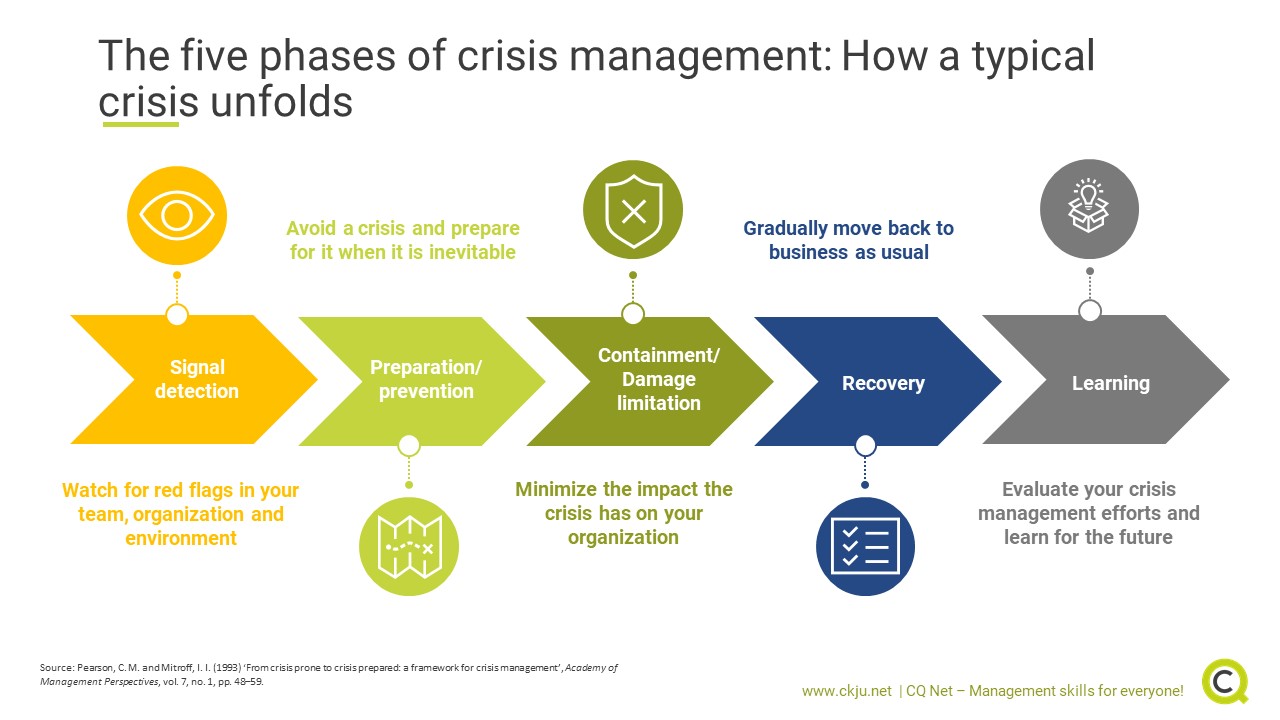- Blog
- Crisis leadership
Contents
- A crisis forces an organization out of its comfort zone
- The coronavirus pandemic is a global threat
- Why is leadership so important in times of crisis?
- Crisis leadership models help to focus in what is important
- The five phases of crisis management: How a typical crisis unfolds
- Signal detection: Watch for red flags in your team, organization and environment
- Preparation/prevention: Avoid a crisis and prepare for it when it is inevitable
- Containment/Damage limitation: Minimize the impact
- Recovery: Gradually move back to business as usual
- Learning: Evaluate your crisis management efforts and learn for the future
- References and further reading
A crisis is triggered when a “high-impact event” (Pearson and Clair, 1998) such as the coronavirus outbreak creates a level of uncertainty and ambiguity that has the potential to disrupt day to day operations.Dr. Markus Nini
A crisis forces an organization out of its comfort zone
A crisis is something that forces an organization out of its comfort zone. Even though most organizations are used to coping with change rather well in a VUCA world, a crisis is something different. A crisis is triggered when a “high-impact event” (Pearson and Clair, 1998), such as the coronavirus outbreak, creates a level of uncertainty and ambiguity that has the potential to disrupt day to day operations.
The coronavirus pandemic is a global threat
The speed in which SARS-CoV-2 has spread around the globe is astonishing. With an exponentially growing number of COVID-19 cases, almost any country, organization and individual has been directly or indirectly affected by the virus. In a fight against it, most governments and organizations follow a containment strategy as suggested by the World Health Organization (WHO). Aggressive measures such as travel bans, curfews and social distancing target at reducing the number of infections. Most experts are convinced that it is too late to stop the coronavirus. However, this “flatting the curve approach” is of critical importance to make sure national healthcare systems are not overwhelmed by a high number of intensive care COVID-19 cases.
Why is leadership so important in times of crisis?
Leadership is a key success factor in times of change and even more important in times of crisis. It encompasses all actions required to move an organization through the crisis into a desired future state. This applies first and foremost to an organization’s leadership team. However, leadership is a core management skill and thus important for all professionals.
When leading your organization through a crisis, it is important to focus both on hard and soft factors. Hard factors refer to all tangible resources such as money, infrastructure and technology necessary for your crisis management efforts (Teo et al., 2017). In contrast, soft factors refer to all activities related to sensemaking, communication, relationship building and coping required to lead your organization through the crisis (Teo et al., 2017).
Crisis leadership models help to focus in what is important
How to lead an organization through a crisis? There is no one size fits all approach. However, there are some crisis management models available you can use as a starting point for your own crisis response. Those models won’t solve the crisis for you but can be used as recipe to structure your crisis management efforts. Having some sort of model at hand is especially important when time is your biggest enemy.
This is also the reason why organizations in the military, healthcare and aviation sector, which frequently operate under time pressure, stick to such models and translate them into checklists, standard operating procedures (SOPs) and communication guidelines. We will have a more detailed look at the five phases of crisis management introduced by Pearson and Mitroff (1993).
The five phases of crisis management: How a typical crisis unfolds
First introduced in 1993 by Pearson and Mitroff, the five phases of crisis management provide a basic structure how a typical crisis usually unfolds (JAMES and WOOTEN, 2005). We will briefly go through each phase in the context of the coronavirus crisis.
Signal detection: Watch for red flags in your team, organization and environment
In most cases, a crisis won’t hit you out of the blue. There are usually some sort of signals or red flags visible on the horizon that indicate something is going to happen. On a global level, the SARS outbreak that took place in 2002-2004 was a warning sign that there would be more to come in the future. As for the coronavirus, there had been signals of a widespread outbreak in as early as December 2019. These signals should have urged you to think about the following questions:
- How serious does your organization take the risk of the coronavirus?
- How would a coronavirus pandemic hit your organization?
- What measures have you taken to be prepared for it?
- Which trusted (online) resources are you going to follow to stay up to date on recent developments?
For most countries this first phase is already over. It is up to you to evaluate whether you have recognized the signals early enough and kicked-off the second phase “preparation/prevention” as a consequence.
Preparation/prevention: Avoid a crisis and prepare for it when it is inevitable
The most efficient leadership approach in times of crisis is to avoid it at all. There are management tools such as situational awareness, a speak-up culture and a systems approach in understanding accidents that can help you to stop a crisis at the very beginning. However, when the crisis is not self-made but a result of environmental factors as is the case with the coronavirus, you need to be prepared to mitigate it.
Other virus outbreaks such as SARS should have urged you already to think about a proper plan to deal with such a virus-induced crisis. As the coronavirus SARS-CoV-2 has been around for a couple of weeks already, you should be prepared to answer the following questions:
- How are you going to ensure the safety of your people during the coronavirus crisis?
- What could you do to minimize the impact (e.g. hygiene measures, home office regulations, respirators)?
- What could you do to keep your team or organization safely running during an outbreak?
- What is your internal and external communication strategy and approach?
- What is your plan to deal with supply chain disruptions due to quarantine measures?
Containment/Damage limitation: Minimize the impact
A crisis such as the coronavirus outbreak is not an event but rather a process (Jaques, 2012). Consequently, once your team or organization is hit (e.g. there is a COVID19 case in your team), you need to be prepared to spend a considerable portion of your time and energy to lead it through the crisis. This involves answering the following questions:
- How are you going to handle a COVID19 case in your organization?
- Which parts of your crisis management plan can be implemented without changes?
- Which parts of the plan have to be adjusted to the specific situation you are in?
- How well does your communication strategy and approach work out?
- How about other activities to limit the damage (e.g. financial impact) to your organization?
In its core, crisis management is change management. Due to the high change momentum and speed, you need to continuously adjust your crisis response efforts to the specific situation. An agile approach is the management tool of choice for such fuzzy and dynamic situations.
Recovery: Gradually move back to business as usual
The coronavirus pandemic is still ongoing and moving back to business as usual won’t be an option soon. Some experts even argue that the crisis is going to have long lasting effects on our society. At this point in time, we don’t know how things will develop. However, there will be a time where vaccines and drugs to fight the coronavirus will be available. This will also be the starting point for you to decide how to gradually move back to business as usual. Some guiding questions you can use for this phase are:
- What signs do you look for to decide when the crisis recovery phase starts?
- Which crisis management measures are still needed during recovery and which ones can be abandoned?
- How are you going to communicate that the crisis is over to your organization?
- How do you make sure that new regulation as a result of the crisis is properly implemented in your organization?
Learning: Evaluate your crisis management efforts and learn for the future
There are already some signs that South-East Asian countries such as Singapore, South Korea and Vietnam have learned their lessons from the 2002-2004 SARS outbreak. The last of the five phases of crisis management (Pearson and Mitroff, 1993) is exactly about evaluating your crisis management efforts and drawing your conclusion for the next crisis to come. Some of the key questions you could use in this last crisis management phase are as follows:
- What went well and what went wrong during the crisis?
- Which feedback do our stakeholder provide you regarding your crisis management efforts?
- Which checklists, standard operating procedures (SOPs) and guidelines should be updated based on your evaluation?
- Which of the lessons learned from other organizations should you take into consideration?
With some countries such as China already having gone through a major coronavirus outbreak, the body of evidence on how to contain it is increasing. This is a great opportunity for you to learn how to best adjust your crisis management efforts based on facts rather than opinion. However, it is not just about you to learn and be prepared for the next crisis to come. Don't underestimate the potential of your organization to learn from the past and be better prepared for the future.
The coronavirus pandemic will be one of the dominating topics for weeks to come. This also applies to professionals like you who work hard to successfully lead their organization, team or project through this difficult time. We hope that this management guide helps you in your crisis management efforts.
Disclaimer: Please note that this article does not claim to be a one-size-fits-all solution with a guarantee of success. It is rather a compilation of scientific evidence interpreted through a lens of current affairs. The author does not take responsibility for any actions, activities or any resulting consequences stemming from this article.
References and further reading
Fred Garcia, H. (2006) ‘Effective leadership response to crisis’, Strategy & Leadership, vol. 34, no. 1, pp. 4–10.
JAMES, E. H. and WOOTEN, L. P. (2005) ‘Leadership as (Un)usual’, Organizational Dynamics, vol. 34, no. 2, pp. 141–152.
Jaques, T. (2012) ‘Crisis leadership: a view from the executive suite’, Journal of Public Affairs, vol. 12, no. 4, pp. 366–372.
Pearson, C. M. and Clair, J. A. (1998) ‘Reframing Crisis Management’, Academy of Management Review, vol. 23, no. 1, pp. 59–76.
Pearson, C. M. and Mitroff, I. I. (1993) ‘From crisis prone to crisis prepared: a framework for crisis management’, Academy of Management Perspectives, vol. 7, no. 1, pp. 48–59.
Teo, W. L., Lee, M. and Lim, W.-S. (2017) ‘The relational activation of resilience model: How leadership activates resilience in an organizational crisis’, Journal of Contingencies and Crisis Management, vol. 25, no. 3, pp. 136–147.
Top Rated
About the Author

Comments
Most Read Articles
Blog Categories
RELATED SERVICES










Add comment